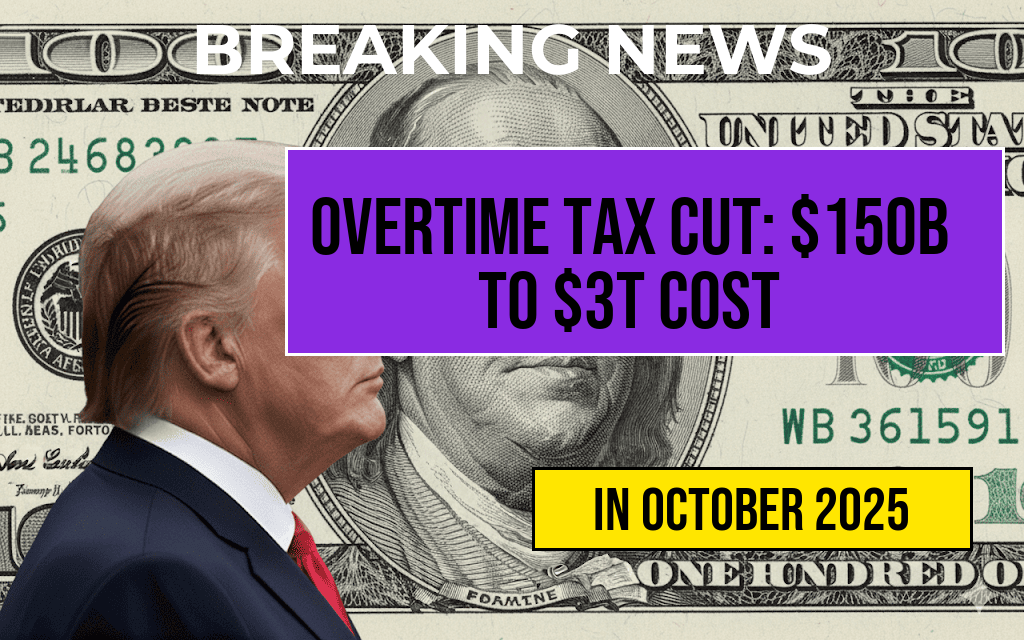The proposed overtime tax cut has stirred significant debate among economists and policymakers, with estimates suggesting it could cost between $150 billion and $3 trillion over the next decade. This wide range reflects varying opinions on the impact such a tax policy could have on the economy and individual workers’ take-home pay. Advocates argue that reducing taxes on overtime pay would incentivize businesses to offer more hours, thus potentially increasing overall wages for employees. Conversely, critics warn that the fiscal implications could lead to a substantial reduction in government revenue, which might impact social programs and public services. As this debate unfolds, many workers are left wondering how these changes might affect their finances and the broader economy.
The Rationale Behind the Overtime Tax Cut
Proponents of the overtime tax cut argue that it could stimulate economic growth by encouraging companies to extend working hours without the burden of increased tax liabilities. By doing so, businesses may be more inclined to hire additional staff or provide overtime, which could lead to higher overall earnings for employees. Additionally, supporters emphasize that workers who are compensated for their extra hours may experience greater job satisfaction, leading to improved productivity.
Potential Economic Benefits
- Increased disposable income: Workers may take home more money, allowing for greater spending and investment.
- Job creation: Businesses may hire more employees to meet increased demand for services.
- Boost in economic activity: Higher consumer spending could stimulate local economies.
Concerns Over Long-term Fiscal Impact
Despite the potential benefits, there are significant concerns regarding the long-term financial implications of the proposed tax cut. Critics highlight that the estimated cost of $150 billion to $3 trillion could drastically affect government budgets, potentially leading to cuts in essential services such as education and healthcare. According to the Forbes, such fiscal policies often lead to budget deficits, which could burden future generations.
Impact on Government Revenue
| Scenario | Estimated Cost |
|---|---|
| Low Estimate | $150 billion |
| High Estimate | $3 trillion |
Implications for Workers
For many employees, the most pressing question is how the overtime tax cut will affect their take-home pay. The potential for increased earnings might be enticing, but the broader repercussions are complex. For instance, if businesses choose to reduce their workforce to offset tax losses, some workers might find themselves with fewer hours or even job loss.
Understanding the Take-Home Pay Effect
To better illustrate the potential changes in take-home pay, consider the following:
- A worker currently earning $50,000 annually may see a modest increase in their paycheck if overtime is taxed less heavily.
- However, if the company reduces its workforce to manage costs, this could lead to job insecurity, negating any potential benefits from the tax cut.
Public Sentiment and Political Landscape
The issue is increasingly becoming a focal point in political debates, with various stakeholders voicing their opinions. Unions and labor advocates often express concern that the tax cut could disproportionately benefit employers at the expense of workers. Surveys indicate that public sentiment remains divided, with many individuals unsure about the long-term effects of such a policy.
What Workers Should Watch For
As the discussion surrounding the overtime tax cut continues, workers are encouraged to stay informed. Monitoring legislative developments and understanding the implications of proposed changes can help individuals better prepare for potential shifts in their financial landscape. Resources such as the IRS and Bureau of Labor Statistics provide valuable information regarding tax policies and labor market conditions.
In an evolving economic climate, the ramifications of the overtime tax cut will undoubtedly shape discussions about labor, wages, and fiscal responsibility in the years to come.
Frequently Asked Questions
What is the proposed overtime tax cut?
The proposed overtime tax cut refers to legislative changes aimed at reducing taxes on overtime pay, potentially affecting how much employees take home after taxes.
How could the financial impact of this tax cut affect my take-home pay?
The financial impact of the tax cut could result in significant changes to take-home pay, with estimates suggesting a potential increase for some workers, while others might see minimal changes.
What is the estimated cost of the overtime tax cut?
Experts estimate that the overtime tax cut could cost between $150 billion and $3 trillion, depending on the scale of its implementation and the number of workers affected.
Who will be most affected by the overtime tax cut?
Workers who regularly earn overtime pay, particularly those in industries with high overtime hours, will likely be the most affected by the overtime tax cut in terms of take-home pay.
Will the overtime tax cut benefit all workers equally?
No, the overtime tax cut may not benefit all workers equally. The impact will vary based on individual income levels, the frequency of overtime work, and other tax considerations.










